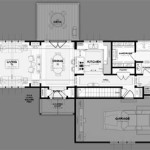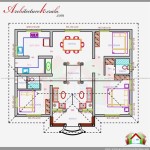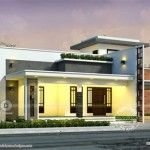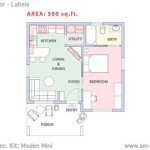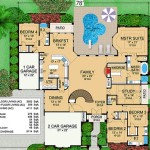Simple Home Floor Plan Design
Designing a floor plan is a crucial first step in building or renovating a home. A well-designed floor plan optimizes space usage, improves functionality, and enhances the overall living experience. Simplicity in floor plan design is often key to achieving these goals, particularly for smaller homes or those seeking a minimalist aesthetic. This article explores the essential aspects of creating a simple, yet effective, home floor plan.
Understanding the needs and lifestyle of the occupants is paramount to designing a successful floor plan. Consider the number of occupants, their ages, and their individual needs. For example, a family with young children may prioritize a play area near the living room, while a retired couple might prefer a larger master suite with easy access to all areas of the house. Analyzing these factors helps to determine the appropriate size and layout of the various rooms.
Defining the desired spatial relationships is another key element in floor plan design. Consider how different rooms interact and how traffic flows between them. An open-plan layout, where the living room, dining area, and kitchen are combined, facilitates social interaction and creates a sense of spaciousness. Conversely, a more traditional layout with distinct rooms offers greater privacy and noise control. The chosen approach should align with the occupants' preferences and lifestyle.
Prioritizing functionality is essential throughout the design process. Each room should be designed with its intended purpose in mind. A kitchen, for instance, should have a logical work triangle connecting the sink, stove, and refrigerator, optimizing efficiency. Bedrooms should be placed in quieter areas of the house for better sleep, while bathrooms should be conveniently located near bedrooms and common areas. Focusing on functionality ensures that the home is practical and comfortable.
Maximizing natural light and ventilation is a crucial consideration for creating a healthy and pleasant living environment. Orienting the house to take advantage of natural light can reduce energy consumption and enhance the overall ambiance. Incorporating windows and skylights strategically can bring in more natural light, while carefully positioned doors and windows can facilitate cross-ventilation, improving air quality and reducing the need for artificial cooling.
Space optimization plays a significant role in creating efficient and comfortable homes, especially in smaller dwellings. Multi-functional spaces, such as a combined living and dining area, can maximize space utilization. Built-in storage solutions, like under-stair storage or wall-mounted shelves, can minimize clutter and free up valuable floor space. Careful consideration of furniture placement and room dimensions can further optimize the use of available space.
Simplicity in design does not necessitate sacrificing aesthetics. A simple floor plan can be visually appealing through careful consideration of proportions, balance, and flow. Clean lines, minimal ornamentation, and a cohesive color palette can create a sense of harmony and tranquility. The choice of materials and finishes also contributes to the overall aesthetic appeal of the home.
Budget considerations are integral to any home building or renovation project. A simple floor plan can often be more cost-effective to build than a complex one, requiring fewer materials and less labor. Choosing standard-sized materials and minimizing intricate details can also help to control costs. Working within a predetermined budget ensures the project remains financially feasible.
Compliance with building codes and regulations is mandatory for all construction projects. Local building codes dictate minimum room sizes, ceiling heights, and other essential specifications. Ensuring the floor plan adheres to these regulations is crucial for obtaining building permits and ensuring the safety and structural integrity of the home.
Seeking professional advice from architects or building designers can be invaluable throughout the design process. These professionals possess the expertise and experience to navigate the complexities of floor plan design, ensuring the final design is functional, aesthetically pleasing, and compliant with all regulations. They can also provide valuable insights into space optimization, material selection, and construction techniques.
Utilizing design software can significantly aid the floor plan creation process. Numerous software programs are available, ranging from basic free tools to sophisticated professional software. These tools allow users to create 2D and 3D models of their floor plans, experiment with different layouts, and visualize the finished product. This can be particularly helpful for those with limited design experience.
Incorporating sustainable design principles in the floor plan can contribute to a more environmentally friendly and energy-efficient home. This can include features such as passive solar heating, rainwater harvesting, and the use of eco-friendly building materials. Sustainable design not only benefits the environment but can also reduce long-term operating costs.
Accessibility considerations are essential for creating homes that cater to the needs of all occupants, including those with disabilities. Features like wider doorways, ramps, and grab bars can enhance accessibility and promote independent living. Incorporating these elements into the floor plan from the outset can ensure the home remains adaptable to changing needs over time.

Simple House Plans Blog Homeplans Com

Est House Plans To Build Simple With Style Blog Eplans Com

Simple House Plan Design With Garage

Stylish And Simple Inexpensive House Plans To Build Houseplans Blog Com

Small House Design 2024001 Pinoy Eplans Floor Plans

Small House Designs Shd 2024003 Pinoy Eplans

Small House Plan Ideas For Diffe Area To See More Read It Floor Plans Kitchen

Simple House Plans Cabin And Cottages 1500 To 1799 Sq Ft

Affordable Home Design Efficient Floor Plans

Stylish And Simple Inexpensive House Plans To Build Houseplans Blog Com

